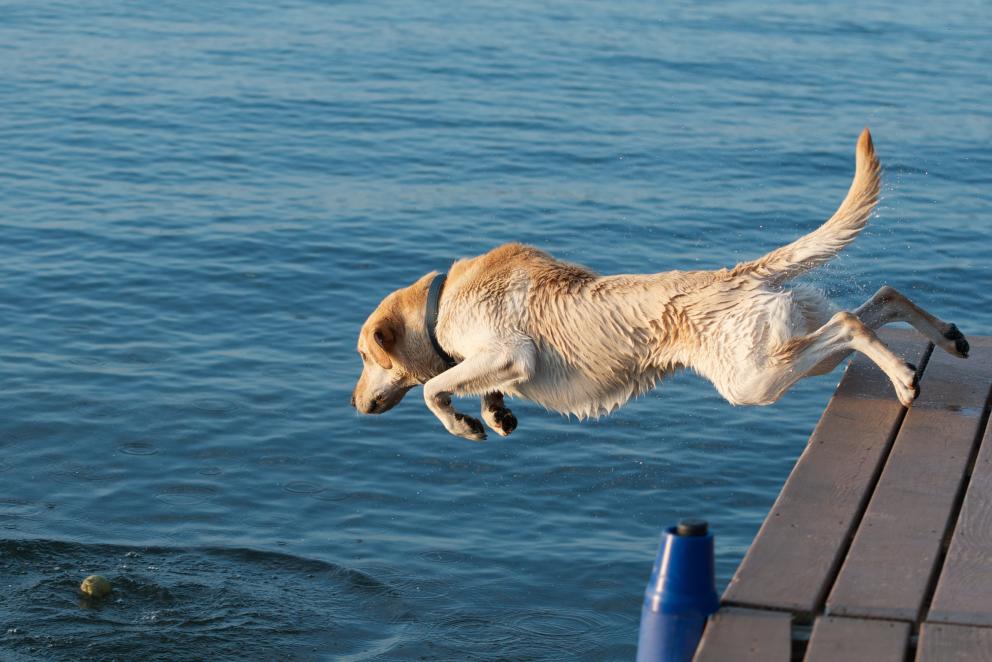You are here
Water Safety Tips for Dogs

Photo credit
For many Canadian families, summer includes activities such as boating and swimming. But each year, tragic and avoidable water-related fatalities occur across Canada. This includes pets. While taking your dog outdoors and into the water is an enjoyable activity for both the owner and the animal, if caution isn’t taken, the situation could potentially turn tragic. We highly recommend talking to your veterinarian when considering taking your pet into the water.
Here are a few important water safety tips for dogs:
- Not all dogs are good swimmers: And even if they are, if they fall overboard, they can get into trouble from exhaustion or hypothermia. Spend time getting to know how strong a swimmer your dog is and see him in practice before hitting the open water! To practice, support your pet’s midsection until he feels comfortable propelling himself.
- Consider a flotation device: If you don’t have a flotation device for your dog, it is extra important to have family members who are playing with the dog wearing their flotation devices; in case they try to help their pet and get into trouble themselves. In a boat, a dog should always wear a lifejacket. The dangers are the same as for humans: Fast currents can carry your pet away quickly; the distance to shore may be further than estimated, or in a different direction than estimated. Hypothermia, muscle cramps and fatigue can set in. Also, if dogs jump from a high speed boat, they can be injured by hitting the water hard.
- Water play: Stay away from sticks and instead use a ball. Sticks have sharp ends, and serious injury has occurred from dogs pouncing on the sharp end of a stick. Remove the collar before your dog goes into the water, especially the chain or slip ones, because they can snag your pet on hidden underwater branches, plants etc.
- Monitor for heat stroke: Though it is impossible to keep your pet from drinking the pool or lake water, providing a fresh water source may help! Also, monitor your pet for signs of dehydration and heat stroke, and keep him off hot sand as it can blister paws.
- After swim: Some dogs are sensitive to skin rashes and swimmer’s ear. As soon as possible after a swim, rinse your dog off with clean fresh water. Clean ears with an ear cleanser specifically formulated for dogs and dry the ears thoroughly. If you know your dog has sensitive skin, also bathe your dog with dog shampoo to get all the chemicals, bacteria and other contaminants off the skin.
Giardiasis
Giardiasis (commonly known as beaver fever) is an intestinal infection that affects people, livestock, and pets. Giardiasis is transmitted through fecal matter, and is contracted by drinking from contaminated bodies of water, especially at spring runoff. Contact your veterinarian if you notice any of the symptoms of giardia:
- Soft, poorly formed, pale, unusually pungent, or mucus containing stool
- Weight loss
- Chronic diarrhea
- Vomiting
Leeches
Leeches can be found in Alberta lakes and ponds, especially where there is a lot of mud at the bottom of the lake. Leeches attach to a host’s skin or mucus membrane for a blood meal, but rarely cause any health issues. Leeches can be removed with gentle traction of the head, so as not to leave attached mouth parts in the skin. Because leeches secret an anticoagulant in their saliva, the area will bleed a little. Bleeding can be controlled with direct pressure. When near a body of water that contains a lot of leeches, it is important to provide fresh drinking water to your dog so they will be less likely to drink from the pond with the risk of getting a leech attached inside its mouth.
Additional Resources:
Alberta Government: Lifejacket Loaner Stations
Canadian Red Cross: Water Safety Week
| Attachment | Size |
|---|---|
| 315.77 KB |
